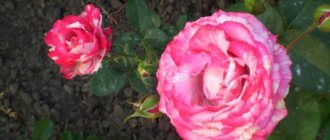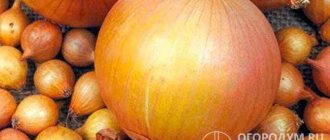Description
Gloria Dei is a hybrid tea variety. The bush can reach a height of 1.2 meters. It is slightly spreading in shape, with straight, leafy stems. Large but sparse thorns are located along the entire length of the shoots. The leaves of the rose are rich green in color and have jagged edges. Its buds are large, reaching 20 centimeters in diameter when fully bloomed.
Gloria Day's double flowers have an interesting feature: they are able to change color throughout their growth. The main color is lemon yellow, this is how the core of the bud is colored. The edges of the inflorescences are pale pink or white. At the beginning of budding, the petals are yellowish-green, gradually becoming bright yellow. When fully dissolved, the inflorescences acquire a pink color from the edges to the middle.
Description of the plant
The bush is characterized by strong branching, reaches a height of 80-200 cm, a width of 90-125 cm (depending on the place of cultivation), and has a reverse pyramidal or hemispherical shape. In the first year of vegetation it may have 2-3 supporting branches, subsequently their number increases to 7-9.
The shoots are powerful, thick, durable, with rare large and sharp thorns. The leaves are medium-sized, dense, with a smooth, shiny surface, jagged edges and clearly visible veins. The color of the leaf blade is green or dark green.
Bloom
"Gloria" flowers are large in size and exceptionally beautiful at all stages of their life cycle. The variety is characterized by abundant, repeating, long-lasting flowering. The first buds bloom in June, and the last ones can form in October.
There is usually one bud on the stem, but sometimes they form inflorescences of several (from 2-3 to 6) flowers. The large bud, about 6 cm high, has a goblet shape.
The flowers are distinguished by the characteristic color of the petals - pale yellow with a pink border.
The flowers are large, up to 17 cm in diameter, densely double, consisting of 25-45 silky petals, which open into a voluminous bowl. The petal is delicate, but tight, with a smooth or wavy edge; as it blooms, it bends, sharpening towards the center. The color is complex: from pale yellow or creamy pink to deep yellow, with a pink-lilac or bright crimson border, it can vary depending on the place of cultivation, the period and stage of flowering. The aroma is most often characterized as moderate: from light, subtle to rich, sweet, fruity and honey.
Experts advise taking into account that the intensity of flowering, the size and color of flowers depend on climatic, soil and temperature conditions, as well as agricultural technology, primarily watering and fertilizing.
Decorative qualities begin to fully develop in the 2-3rd year after planting, when the plant gains sufficient vegetative mass. During the first flowering period, an adult bush can form more than 40 buds, but the flower lasts about 3-4 days. The second stage of flowering is less abundant, but longer.
The variety is very popular among gardeners, as it fits perfectly into landscape design, combining perfectly with other plants. It is used to form rose gardens and mixborders, through fencing, decorating rock gardens and rock gardens. In the case of solo planting, the bushes are placed in a heap, forming three-dimensional groups.
"Gloria Day" fits perfectly into landscape compositions with evergreen, decorative deciduous, ground cover, small-flowered and other plants
"Gloria Day" is also grown commercially for cutting. Its petals serve as raw materials for making rose jam and are used in cosmetology.
Characteristic
Gloria Day flowers have a delicate aroma with notes of fruit and honey. It changes under different growing conditions. The variety is resistant to most species diseases. The rose will show its best decorative qualities when grown in an area well lit by sunlight. Gloria Day is frost-resistant, but if the winter is expected to be too cold, it needs to be covered.
Note! During a sudden thaw, the shelter must be removed to prevent the roots from drying out.
Main characteristics
Let's get acquainted with the key features of the variety:
| Parameter | Characteristic |
| Culture | Rose (Rosa L.) |
| Variety | Gloria Day |
| Garden group | Hybrid tea (CH) |
| Form | Bush |
| Life cycle | perennial |
| Purpose | Decorative |
| Reproduction | Vegetative (by cuttings or grafting) |
| Bush height | 1-1.5 m |
| Flowering type | Repeat flowering (almost continuously) |
| Flowering period | June – October |
| Type of flower | Dense double |
| Number of petals | 26-45 pcs. |
| Flower diameter | 13-17 cm |
| Petal coloring | Delicate yellow with pink-raspberry edge |
| Disease resistance | Average |
| Frost resistance | Up to −23 ℃ |
| Year of registration in the State Register | 1970 |
| Originator | Agricultural production complex "Plemzavod Maysky" (Vologda region) |
Hybrid tea rose "Gloria Day" is distinguished by abundant and long-lasting flowering, and its large flowers show variability in color and intensity of aroma
Resilience of climbing rose Gloria Day
The Gloria Day variety is characterized by fairly high resistance to frost, however, when growing this perennial shrub in the middle zone and regions with similar weather conditions, it is recommended to cover it before the onset of cold weather. The resistance of this flowering shrub to powdery mildew and black spot is average. This rose is also resistant to the rainy season, the color of the petals does not fade.
Pros and cons of the Gloria Day variety
Advantages:
- A famous variety with an interesting history, known throughout the world;
- Bright, large buds, two-tone colors;
- Long flowering;
- High quality plant;
- Good frost resistance;
- Pronounced aroma;
- Suitable for cutting;
- Tall, slender bush.
Flaws:
- Difficulty in planting and care;
- Constant disease prevention is necessary;
- Flowers fade in the sun;
History of the rose
Gloria Day was bred by the French - father and son Mayan in the 30s of the 20th century. They named this variety “Madame Meiyang”, in honor of the wife and mother of the breeders. Rose cuttings were sent to nurseries in Germany, Italy, and the USA to familiarize themselves with it and receive feedback. But contacts were interrupted by the war.
Each country that received a cutting was able to save it. In Italy the rose was called Gioia ̶ Delight, the Americans gave it the name Peace ̶ Peace. In Germany, experts named it Gloria Dei, which translated sounds like “Glory to the Lord.” This name has also taken root in Russian-speaking countries.
Diseases and pests of the Gloria Day variety
In general, the plant has good immunity. The State Register of Breeding Achievements of the Russian Federation states that the variety is not affected by powdery mildew. Gardeners note that roses can be eaten by aphids. These are very small yellow-green insects that are visible when examining a rose on the buds and leaves. The drug Iskra-M helps well if the treatment is carried out immediately after detection of pests.
Aphids on roses must be destroyed immediately after detection.
In unsuitable conditions, bushes suffer from black spot, a fungal disease in which the leaves become covered with black spots about 5 mm in size and then fall off. A bush affected by this disease winters worse. Spraying roses with Abiga-Peak twice a season helps.
Only one goblet-shaped bud appears on each peduncle. The flowers are densely double, each with about 55 delicately colored petals - creamy-yellow in the middle and pink in the edges. The diameter of the flowers is 12-14.5 cm. The blooming buds exude a delicate, pleasant aroma.
Varieties
For several decades now, Gloria Day has been the best hybrid tea rose. She is not only beautiful, but also resistant to many diseases. Almost 400 varieties of roses have been bred on its basis. The following varieties have gained the most popularity:
- Gold Crown;
- Talking sun;
- Princess of Monaco;
- Fiery World;
- Reception of guests in the garden.
In addition, breeders have bred the climbing rose Gloria Day. It can reach a height of 3 meters. The color of its buds is the same as that of the bush species. The climbing rose blooms from June until the first cold weather.
See also
When and how to prune roses correctly, care rules, feeding and wateringRead
Additional Information. In Catholicism, a red rose symbolizes earthly life, while a white rose symbolizes heavenly life.
Reviews from gardeners
Elena, 57 years old, Yaroslavl
She is beautiful, this gentle Frenchwoman, but she knows how to cause me anxiety. It doesn’t take much time to care for, but I’m constantly worried whether the cold wind will blow through it, whether the buds will open, since it puts out fresh shoots later than other varieties, has it overwintered well? And Gloria, deceiving me with her eternal delay, continues to grow, bloom and decorate my garden for the second decade! Caring for it is quite simple: rare, abundant watering under the bush, fertilizing three times a season, pruning in the fall. For the winter I cover it with sawdust. Aphids love its tender leaves, but I do not use toxic chemicals; I inspect the young shoots and carefully crush the pests with my fingers. She has another nice feature: in cold rainy weather, flowers smell differently than in dry and hot weather.
Svetlana, 48 years old, Kostroma
I've wanted this particular variety for a long time. I searched for a long time until I managed to find the real one. I planted the cuttings in early May. It was a great pity to cut off the buds that it produced with enviable regularity in the first summer, but there was no other way: in the first year the bush needs strength to develop the root system. After the first winter we had to prune it back a lot, but its buds were so huge and the aroma was incredibly strong! I have it growing surrounded by sage and feeling great for the third year now, I haven’t noticed any illnesses.
Arina, 36 years old, Moscow region
We planted several bushes four years ago on the east side, in front of the bedroom window, and now in the summer we fall asleep every evening and wake up every morning with an amazing aroma. Moreover, it becomes strongest in the evening, when the heat subsides. Gloria makes us happy regularly, every year, there are a lot of buds and blooms all summer. I periodically trim the bushes, then new shoots give good flowering.
Maxim, 45 years old, Rostov
My Gloria blooms until October, and its last bloom is quite intense and with large flowers. It is not afraid of frost, but strong winds can damage the bushes; this should be taken into account when planting. The only disease I had to deal with was black spot. I treat this problem with a 3% solution of copper sulfate until the buds open. If the plant is already affected, it is worth treating the soil around it. Otherwise, the rose is undemanding and easy to care for: mulching, fertilizing (I use potassium), pruning, removing faded buds.
Features of cultivation
To grow a rose with a pronounced decorative appearance, you must adhere to certain rules.
When to plant
The Gloria Day rose is planted in the spring, before the buds open. The soil should completely thaw and warm up by the time of planting. In warm regions, bushes can also be planted in the fall. The optimal time for this is September. Plants planted this month have time to take root and strengthen before the winter cold.
Preparation of planting material
Before the planting procedure, the seedlings are pruned. The bush should have no more than 3-4 strong trunks, which are shortened to 10-15 centimeters. As a result, 2-4 buds remain on each shoot. The roots of Gloria Day are pruned in such a way that small branches are preserved on them. To prevent drying out, the root system is dipped in a mash consisting of cow dung (1 part) and clay (2 parts).
Choosing a place in the garden and planting
The place where Gloria Day will grow must meet the following requirements:
- it should be well illuminated by the sun, especially in the morning;
- be protected from drafts;
- the site must be selected with a slope to the south;
- the soil should be nutritious, light, moisture-permeable;
- the predecessors should not be roses.
To make caring for roses easier, they are planted in rows. Planting is done as follows:
- the root system is lowered for 1 hour into a bucket of water in which a growth stimulator is dissolved;
- a hole measuring 60 × 60 centimeters is dug;
- drainage consisting of expanded clay, small pebbles, and sand is laid at its bottom;
- substrate is poured on top;
- the roots are straightened and the seedlings are placed in the planting hole so that the grafting site is 3-5 centimeters below the ground level;
- the plant is watered, then hilled to a height of 15 centimeters to prevent drying out.
When the seedlings take root and the buds begin to grow, they are unplanted. The soil in the root circle is mulched with mown grass or peat with a layer of 3-5 centimeters.
Growing a flower, how to plant it correctly in open ground
Fertile and organic-rich soils are considered favorable for rose growth. Fertile black soils and peat bogs saturated with manure are ideal for planting. Another important condition for growing a flower is sufficient sunlight; without this, it is unlikely that it will be possible to obtain the indicators indicated in the description of the variety.
In what form is planting carried out?
Rose Scarlet - description of a climbing variety
For planting, grown seedlings aged 1-2 years are used. The variety can be propagated by seeds, cuttings, layering and grafting onto decorative rose hips. On an industrial scale, the method of planting by cuttings and propagation by grafting is used. In small rose gardens it is better to plant by cuttings, layering or grafting. Seed propagation is rarely used today.
What time does boarding take place?
The favorable time for planting is considered to be from mid-April to mid-October. When planting in spring, it is possible to obtain a powerful vegetation of shoots throughout the season, but flowering will be late, it will begin at the end of July.
Interesting information! When planted in autumn, the plant will have time to take root in its new location and in the spring will enter a period of full development and flowering.
Selecting a location
For planting, lighted places with rich soil are selected. This type of rose, however, like other roses, is very jealous of its location. It is advisable that no roses have grown on the site for the previous 10 years. Optimal predecessors may be legumes or asters.
When planting, the size of the future bush is also taken into account - a height of 1.2-1.5 meters. Therefore, when laying out a flower bed, it is advisable to provide 2-2.5 square meters for one bush.
Roses feel great in sunny areas and tolerate partial shade relatively easily. It is better not to plant in the shade - this will lead to depletion and withering of the bush.
rose flower
How to prepare soil and flowers for planting
At the site where the seedlings are planted, a hole is made into which a mixture of organic fertilizers, peat and fertile soil is added. Before planting, the seedling is freed from the transport packaging and the root system is refreshed - the root system is carefully trimmed with garden shears, cutting off approximately 0.3-0.5 cm of the root tips. This pruning provides an incentive for rapid resumption of growth.
When refreshing, inspect the cut of the roots; they should be white. After this, soak in a solution of root or other growth stimulant for 4-6 hours.
Step by step landing procedure
Before planting, it is recommended to dig up and loosen the area for planting 5-7 days before planting, add compost and an infusion of organic fertilizers. After this, the area is mulched. On the day of planting, a planting hole of the required size is opened and soil is prepared for backfilling - a mixture of peat, compost and fertile soil.
A mound of fertile soil is poured in the center of the hole. A seedling is installed on it. After installation, the roots must be spread to the sides to increase the area. Next, the hole is filled with prepared soil and watered.
When planting grafted roses on rose hips, the planting is done so that the grafting point is 5-7 cm below the ground level. This technique will ensure the growth of roots from the rose trunk, forming over time a full-fledged root system and minimizing the threat of the hybrid degenerating into a rose hip.
Care instructions
Throughout the season, the Gloria Day rose requires a certain amount of care.
Watering
Lack of moisture will adversely affect the plant: the brightness and juiciness of the leaves and buds will disappear. Its excess can lead to diseases of plantings with various rots. Therefore, it is necessary to water the rose, depending on the dryness of the soil, 1-2 times a week, spilling 5-7 liters of water under each bush. The best time for the procedure is morning.
Important! Roses should not be watered at midday, otherwise the leaves will be burned by droplets of moisture.
See also
The best varieties of park roses, planting and care in open ground for beginnersRead
Top dressing
The first fertilizing is done in the spring, during the period of bud break, with organomineral fertilizers. The ground is pre-watered with plain water. This is done to prevent burns to the root system. The bushes are fertilized a second time at the end of July with mineral fertilizer, and again at the beginning of September to prepare the bushes for winter.
Trimming
This procedure solves the following problems:
- Forms the crown of the bush.
- Sets the shoots in the desired direction: if the cut is made with a slope from the outer bud, new shoots will grow outward, if from the inner bud (for example, to straighten drooping branches), they will grow inward.
- Performs a sanitary function. In this case, old, diseased, weak shoots are removed.
- Revives dormant branches.
The stems are trimmed with a sharp, disinfected instrument. The cut is made at a distance of 0.5 centimeters from the kidney.
Features of agricultural technology
Despite the fact that the variety was bred a long time ago, it has good immunity and successfully takes root in different regions.
Choosing a landing site
This variety will perform well in both bright sun and partial shade, only the colors will be slightly different:
- in the sun, the yellow color will fade, and the pink will be brighter, even crimson;
- in partial shade, the yellow tint will remain bright, and the pink will become softer and paler.
Depending on the location, the Gloria Day rose changes color
It is not recommended to plant Gloria Day in the shade. You can choose an area for her that is illuminated by the sun until lunchtime - this will be quite enough.
The variety does not like large amounts of water, especially when it stagnates in the soil - this can cause the roots of the plant to rot. Therefore, bushes should be planted in elevated areas, and in no case in lowlands.
The best predecessors will be legumes (peas, beans). Thanks to the ability of these plants to absorb nitrogen from the air, the soil will be saturated with useful microelements. But it is not recommended to plant Gloria Day after roses and especially rose hips: since the variety is prone to black spot disease, it can “inherit” pathogens from the soil.
Soil requirements
All roses love soils that have a lot of organic matter, so the flowerbed needs to be filled with rotted manure or compost in the fall. This will ensure long and abundant flowering next year. Gloria Day grows best on chernozems, but can also live on other types of soil, subject to timely fertilizing. Clay soils and loams are the most unsuitable for roses of this variety.
Chernozem is best suited as soil for all roses.
Protection from diseases and pests
Gloria Day is not very susceptible to diseases, but they still exist. Most often this happens due to improper care. With excess moisture, the rose is affected by certain rots. This also happens due to too thick plantings and excess nitrogen fertilizers. The affected parts of the diseased plant are cut off, then it is sprayed with a fungicide.
Too dry air is a favorable environment for the development of spider mites. Another common pest of Gloria Day is aphids. To prevent the appearance of various harmful insects, it is necessary to carefully remove all foliage and weeds from the root circle. When there is a large pest infestation, the bushes are sprayed with insecticides.
Diseases, pests and ways to combat them
The most dangerous to the plant are aphids, thrips, nematodes and spider mites. If signs of pest damage appear on the bush, immediate treatment with insecticides is done. Powdery mildew, rust, and fungal diseases of roses are rarely affected. But in case of damage, it is recommended to treat the plant with complex preparations to protect against plant diseases.
By following these simple plant care rules, you can get a beautiful, healthy rose bush that will delight the owner for many years. Experienced gardeners say that Gloria should be in the collection of every self-respecting rose lover.
Flower breeding
Gloria Day is propagated at home in the following ways:
- By cuttings. This is the most common method among gardeners. To do this, a shoot is cut at an angle of 45° from the bottom of the bush, which is then divided into 3-4 parts. Each division should have 3-4 internodes. The cuttings are first rooted in water, or immediately planted in the ground and covered with a glass container.
- By layering. The lower shoots are pinned to the ground, then sprinkled with earth. The place where the branches come into contact with the ground is constantly moistened. When roots appear on the shoots, they are separated from the mother plant and planted in separate holes.
- Vaccination. The procedure is carried out by grafting a cutting or bud onto a rosehip root.
Propagation of Gloria Day by seeds is a labor-intensive process and is usually not used by gardeners at home. This method is used by breeders to breed hybrids.
Flower propagation
Reproduction is carried out by growing seedlings from seeds, cuttings, layering and grafting cuttings onto rose hips. Approximately 1-1.5 years, while the effectiveness reaches only 30–40%.
On a note! When growing bushes from cuttings, you can obtain a viable bush within 1 year.
When is it produced?
The seeds are collected at the end of the season when fruits appear in place of the buds. After drying and disinfection, the seeds are sown in mid-March in containers. The emergence of seedlings is expected by mid-April. Harvesting cuttings is done after the first flowering period in June-July.
On a note! Rooting is usually completed by the end of the 4th week or by mid-August.
Layers are formed in June, so that by October the bush is ready for replanting with a normal root system. It is better to graft roses in July-August; this is the most favorable time for rootstock cuttings of roses for rose hips.
Detailed description
For rooting, cuttings are selected 8-10 cm long with 5-7 live and healthy buds. The procedure is done directly at the planting site, with the lower 4-5 buds buried in the ground. After this, the cuttings are watered abundantly and covered with a jar. Under normal conditions, a viable young bush appears after 21-28 days.
Layers are formed on young shoots in June. To speed up the rooting process, the buds on the shoot are cut off. The shoot is pressed to the ground so that under the soil layer there is a section 10-12 cm long. The top of the shoot is fixed vertically on a support. A mound of earth 10-12 cm high is poured over the fixed area. The young bush will be ready for replanting in the fall.
On a note! Vaccinations are done in July-August. To do this, take a young bud with a piece of wood about 3 cm long. A cut is made in the bark of the rosehip shoot, where the bud is inserted. The grafting area is fixed with electrical tape or tape. The rosehip shoot is shortened 2-3 cm above the bud and treated with garden varnish.
Application in landscape design
Gloria Day is a universal rose variety, both combined with other green spaces and growing as a tapeworm. If the bush is planted singly, then a lawn is sown around it, against which the rose will look like a bright spot. She herself will be the middle ground for taller plants. The planting serves as a decoration for public gardens, parks, flower beds, and rock gardens.
Advice! The combination of roses and coniferous plants will look mutually beneficial.
Rose Gloria Day is the most common hybrid tea variety. It is highly decorative and unpretentious, which has made it popular all over the world. It is planted to decorate the garden and is also used as a cut plant.
The need for pruning and preparation for winter
The Gloria Day rose is pruned, like other varieties, several times per season:
- in the spring, inspect the bush and remove damaged, diseased, dried branches;
- in the summer, non-flowering shoots are cut out, which fatten and take away the strength of the bush, but at the same time they will not produce buds either this year or the next;
- In the fall, before wintering, the entire bush is pruned at a height of 7–10 cm from the ground.
It is impossible to trim the Gloria Day rose too low; it does not tolerate such a procedure well.
All cuts are made with a well-sharpened, disinfected pruner, at an acute angle.
Gloria Day has overwintered and is blooming... Happy! This is my second one, I ruined the first one with a short pruning, only then I read that she doesn’t like it.
Samaritan woman
https://www.forumhouse.ru/threads/53888/page-3
Before wintering, the pruned bush is covered with spruce branches to protect it from rodents, and on top with spunbond. It is important to cover on time: if you do it too early, the rose will dry out, and if it is done too late, it will freeze. For Gloria Day, the rule is that later is better than earlier, since she tolerates frosts well, but the excess moisture that inevitably forms under the shelter in warm weather is bad. You can prune when the air temperature drops below zero.
You need to cover the Gloria Day rose when the air temperature drops below zero.
Awards
In August 1945, the All-American Bureau of Rose Breeding awarded the Peace variety a prize, and it was on this day that the war with Japan ended. And on the day the peace treaty with Japan was signed, our heroine was awarded the Gold Medal - the highest award of the American Rose Society. Isn’t it an amazing coincidence, considering that all the events were planned long before the historical events. The peak of popularity of the variety occurred in the 50s and 60s of the last century. It was then that awards rained down on the beautiful flower as if from a cornucopia. In 1965, Gloria Day was awarded the title “Golden Rose” in The Hague. In 1976, he was inducted into the Hall of Fame by decision of the World Federation of Rose Societies. In 1993, the Garden Merit Award was awarded from the Royal Horticultural Society.
Planting and agricultural technology
Before choosing a planting time, analyze the climatic conditions of the region, because the success of the event will depend on the correct timing. Although many gardeners prefer to carry out this procedure in the fall - a month before the onset of persistent cold weather. Choose a sunny place, because the rose is light-loving and loves to bathe in the rays of the sun. But again, there are nuances. If you are a resident of the sultry south, then choose a place in such a way that during the midday hours the queen of the flowerbed is protected by light partial shade. Gloria Day develops best at temperatures from 15 to 28 °C. The soil should be nutritious and light, with moderate acidity.
Watering is required abundantly, but the soil should have time to dry out between waterings. Nutrients are necessary for bright flowering, so regular fertilizing with universal fertilizers will benefit the rose. It is especially important to feed the plant before the second flowering. Gloria Dei does not tolerate heavy pruning. During the growing season, it is necessary to remove faded flowers in a timely manner, allowing the developing buds to open on time. If there is no snow cover in winter, and the temperature drops below critical, then the bush must be covered with dry soil and covered with any breathable material. Spruce branches or lutrasil are suitable for this. Rose canina (dog rose) or rugosa (wrinkled rose hip) are used as grafting.
Gloria Day is rightfully considered a strong and hardy variety that forgives inept gardeners their small flaws. Magnificent flowering evokes wonderful feelings and positive emotions in those around you. This low-maintenance plant is very popular in landscape design; it is excellent when planted alone and will not get lost in a composition with other plants and varieties of roses. A large bud and a long stem are the components of a beautiful bouquet, so the variety is often grown for cutting. To create an unusual design for a relaxation corner in the garden, the plant is formed as a standard form. There are a lot of amazing reviews about this variety; even after dozens of years, Gloria Day continues to win hearts. This variety is rightfully recognized as the rose of the 20th century, as Robert Pyle presciently spoke about, with whose words I want to end the story about an amazing flower with a difficult fate: “It is so magnificent, full of promise, and I am already sure that this will be the greatest rose of the century.”
History of selection
The French nursery Meyland became the birthplace of the most famous variety, Gloria Dei. Gardener Joseph Rambaud, who had a special love for roses, gave birth to a business that became his life's work. It was continued by his daughter, son-in-law and grandson Francis. It was he who in 1935 grew 50 hybrids from seeds brought from the USA. Examining the newly blooming flowers, the young breeder noticed a pink and yellow specimen. Two of the three buds on the seedling died. From the third appeared the famous “Gloria Day”.
During this period, the plant did not yet have status or a registered name, but was extremely popular; it was sent from the nursery to many countries on orders from breeders and gardeners. The established ties were disrupted by the war that began in 1939 and swept across Europe. Roses were given their own names in different countries. In her homeland she was called “Madame Meilland” (Mine A. Meilland), the Italians gave her the name “Delight” (Gioia), in Germany - “Glory to the Lord” (Gloria Dei), in the USA - “Peace”. The rose was delivered to the USSR under the name “Gloria Day”.
She became a symbol of peace - she survived in harsh times, flowers were awarded at the UN Assembly in 1945. The variety often received awards at competitions and exhibitions.











